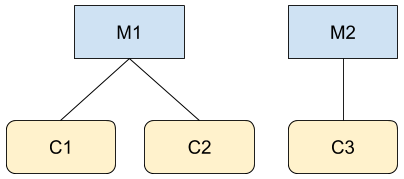CustomerService içindeki ListAccessibleCustomers yöntemiyle erişebildiğiniz müşterileri listeleyebilirsiniz. Ancak bu tür bir istekte hangi müşterilerin döndürüldüğünü anlamak gerekir.
Erişilebilir müşterileri listeleme, Google Ads API'deki birkaç istekten biridir ve istekte müşteri kimliği belirtmenizi gerektirmez. Ayrıca istek, sağlanan tüm login-customer-id'leri yoksayar.
Elde edilen müşteri listesi, OAuth kimlik bilgilerinize dayanır. İstek, mevcut kimlik bilgilerinizle doğrudan işlem yapabileceğiniz tüm hesapların listesini döndürür. Bu, hesap hiyerarşisindeki tüm hesapları içermez. Yalnızca kimliği doğrulanmış kullanıcınızın hesaba yönetici veya başka haklarla eklendiği hesapları içerir.

Şekilde gösterilen iki hiyerarşideki M1 ve C3 için yönetici olan A kullanıcısı olduğunuzu düşünün. Google Ads API'ye bir çağrı yapmanız durumunda (ör. GoogleAdsService için) M1, C1, C2 ve C3 hesaplarıyla ilgili bilgilere erişebilirsiniz. Ancak CustomerService.ListAccessibleCustomers için yapılan bir çağrı yalnızca M1 ve C3 değerlerini döndürür. Çünkü kullanıcı A'ın doğrudan erişimi olan tek hesaplar bunlardır.
Aşağıda, CustomerService.ListAccessibleCustomers yönteminin kullanımını gösteren bir kod örneği verilmiştir:
Java
private void runExample(GoogleAdsClient client) { // Optional: Change credentials to use a different refresh token, to retrieve customers // available for a specific user. // // UserCredentials credentials = // UserCredentials.newBuilder() // .setClientId("INSERT_OAUTH_CLIENT_ID") // .setClientSecret("INSERT_OAUTH_CLIENT_SECRET") // .setRefreshToken("INSERT_REFRESH_TOKEN") // .build(); // // client = client.toBuilder().setCredentials(credentials).build(); try (CustomerServiceClient customerService = client.getLatestVersion().createCustomerServiceClient()) { ListAccessibleCustomersResponse response = customerService.listAccessibleCustomers( ListAccessibleCustomersRequest.newBuilder().build()); System.out.printf("Total results: %d%n", response.getResourceNamesCount()); for (String customerResourceName : response.getResourceNamesList()) { System.out.printf("Customer resource name: %s%n", customerResourceName); } } }
C#
public void Run(GoogleAdsClient client) { // Get the CustomerService. CustomerServiceClient customerService = client.GetService(Services.V22.CustomerService); try { // Retrieve the list of customer resources. string[] customerResourceNames = customerService.ListAccessibleCustomers(); // Display the result. foreach (string customerResourceName in customerResourceNames) { Console.WriteLine( $"Found customer with resource name = '{customerResourceName}'."); } } catch (GoogleAdsException e) { Console.WriteLine("Failure:"); Console.WriteLine($"Message: {e.Message}"); Console.WriteLine($"Failure: {e.Failure}"); Console.WriteLine($"Request ID: {e.RequestId}"); throw; } }
PHP
public static function runExample(GoogleAdsClient $googleAdsClient) { $customerServiceClient = $googleAdsClient->getCustomerServiceClient(); // Issues a request for listing all accessible customers. $accessibleCustomers = $customerServiceClient->listAccessibleCustomers(new ListAccessibleCustomersRequest()); print 'Total results: ' . count($accessibleCustomers->getResourceNames()) . PHP_EOL; // Iterates over all accessible customers' resource names and prints them. foreach ($accessibleCustomers->getResourceNames() as $resourceName) { /** @var string $resourceName */ printf("Customer resource name: '%s'%s", $resourceName, PHP_EOL); } }
Python
def main(client: GoogleAdsClient) -> None: customer_service: CustomerServiceClient = client.get_service( "CustomerService" ) accessible_customers: ListAccessibleCustomersResponse = ( customer_service.list_accessible_customers() ) result_total: int = len(accessible_customers.resource_names) print(f"Total results: {result_total}") resource_names: List[str] = accessible_customers.resource_names for resource_name in resource_names: # resource_name is implicitly str print(f'Customer resource name: "{resource_name}"')
Ruby
def list_accessible_customers() # GoogleAdsClient will read a config file from # ENV['HOME']/google_ads_config.rb when called without parameters client = Google::Ads::GoogleAds::GoogleAdsClient.new accessible_customers = client.service.customer.list_accessible_customers().resource_names accessible_customers.each do |resource_name| puts "Customer resource name: #{resource_name}" end end
Perl
sub list_accessible_customers { my ($api_client) = @_; my $list_accessible_customers_response = $api_client->CustomerService()->list_accessible_customers(); printf "Total results: %d.\n", scalar @{$list_accessible_customers_response->{resourceNames}}; foreach my $resource_name (@{$list_accessible_customers_response->{resourceNames}}) { printf "Customer resource name: '%s'.\n", $resource_name; } return 1; }
curl
# Returns the resource names of customers directly accessible by the user # authenticating the call. # # Variables: # API_VERSION, # DEVELOPER_TOKEN, # OAUTH2_ACCESS_TOKEN: # See https://developers.google.com/google-ads/api/rest/auth#request_headers # for details. # curl -f --request GET \ "https://googleads.googleapis.com/v${API_VERSION}/customers:listAccessibleCustomers" \ --header "Content-Type: application/json" \ --header "developer-token: ${DEVELOPER_TOKEN}" \ --header "Authorization: Bearer ${OAUTH2_ACCESS_TOKEN}" \
İptal edilen hesapları listeleme
Google Ads API, bir yönetici hesabı altındaki iptal edilmiş hesapları listelemek için doğrudan bir yöntem sağlamaz. Ancak bu listeyi almak için aşağıdaki geçici çözümü kullanabilirsiniz.
customer_client_linkkaynağını kullanarakACTIVEbağlantılarının listesini alın vecustomer_client_link.client_customeralanını kullanarak bir müşteri listesi oluşturun.SELECT customer_client_link.client_customer, customer_client_link.status FROM customer_client_link WHERE customer_client_link.status = ACTIVEcustomer_clientkaynağını kullanarakENABLEDhesaplarının listesini alın.SELECT customer_client.id, customer_client.descriptive_name FROM customer_clientİki liste arasındaki fark, iptal edilen hesapların listesini verir.

